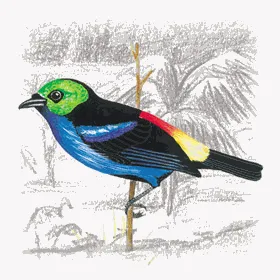
Paradise Tanager
[order] Passeriformes | [family] Thraupidae | [latin] Tangara chilensis | [UK] Paradise Tanager | [FR] Calliste septicolore | [DE] Siebenfarbentangare | [ES] Tangara Siete Colores | [IT] Tangara del Paradiso | [NL] Paradijstangare
Subspecies
| Genus | Species | subspecies | Breeding Range | Breeding Range 2 | Non Breeding Range |
| Tangara | chilensis | SA | Amazonia | ||
| Tangara | chilensis | caelicolor | |||
| Tangara | chilensis | chilensis | |||
| Tangara | chilensis | chlorocorys | |||
| Tangara | chilensis | paradisea |
Physical charateristics
It has bright and unmistakable plumage with an apple-green head and black upperparts. Above the lower back is scarlet and the rump is either scarlet or orange-yellow. Underparts are mainly turquoise. The beak and legs are black
Listen to the sound of Paradise Tanager
[audio:http://www.aviflevoland.nl/sounddb/P/Paradise Tanager.mp3]
Copyright remark: Most sounds derived from xeno-canto
| wingspan min.: | 0 | cm | wingspan max.: | 0 | cm |
| size min.: | 14 | cm | size max.: | 15 | cm |
| incubation min.: | 13 | days | incubation max.: | 17 | days |
| fledging min.: | 0 | days | fledging max.: | 0 | days |
| broods: | 0 | eggs min.: | 0 | ||
| eggs max.: | 0 |
Range
Found in South America, they are fairly widespread and can be seen in Venezuela, Peru, Colombia, Ecuador, Brazil and the upper parts of the Amazon. Paradise Tanager is also found in the lower Amazon Basin, in the northeast, adjacent to the Guyanas, and absent from the central and southeast basin. The Paradise Tanager is distributed in a broad arc round the north and west of the Amazon Basin. It appear to be absent from much of central Amazonia and south of the Amazon. In Suriname a typical bird of the interior.
Habitat
It is found in the canopy and edges of humid forest where it is often in mixed canopy flocks.
Reproduction
The cup shaped nest is built high up in the canopy (30 meters up) in a small outer branch fork. The nest is built of long moss and fungus strings and spider web. It is lined with grass. As in most Tanager species the female is responsible for the nest building. Clutch size is 2-4 eggs incubated by the female. No data on fledging period.
Feeding habits
Lives in mixed flocks feeding high in canopy on fruit e nberries. Also hunts for insects in foliage.
Conservation
This species has a large range, with an estimated global Extent of Occurrence of 4,500,000 km². The global population size has not been quantified, but it is believed to be large as the species is described as ‘common’ in at least parts of its range (Stotz et al. 1996). Global population trends have not been quantified, but the species is not believed to approach the thresholds for the population decline criterion of the IUCN Red List (i.e. declining more than 30% in ten years or three generations). For these reasons, the species is evaluated as Least Concern.

Migration
Sedentary throughout range, although seasonal fluctuations occur
Distribution map

Literature
Title Observations at a Paradise Tanager nest
Author(s): TERESA M . WOOD,
Abstract: The Paradise Tanager (Tanguru chifensis) inhabits ..[more]..
Source: Wilson Bull., 104(2), 1992, pp. 362-365
]]>
